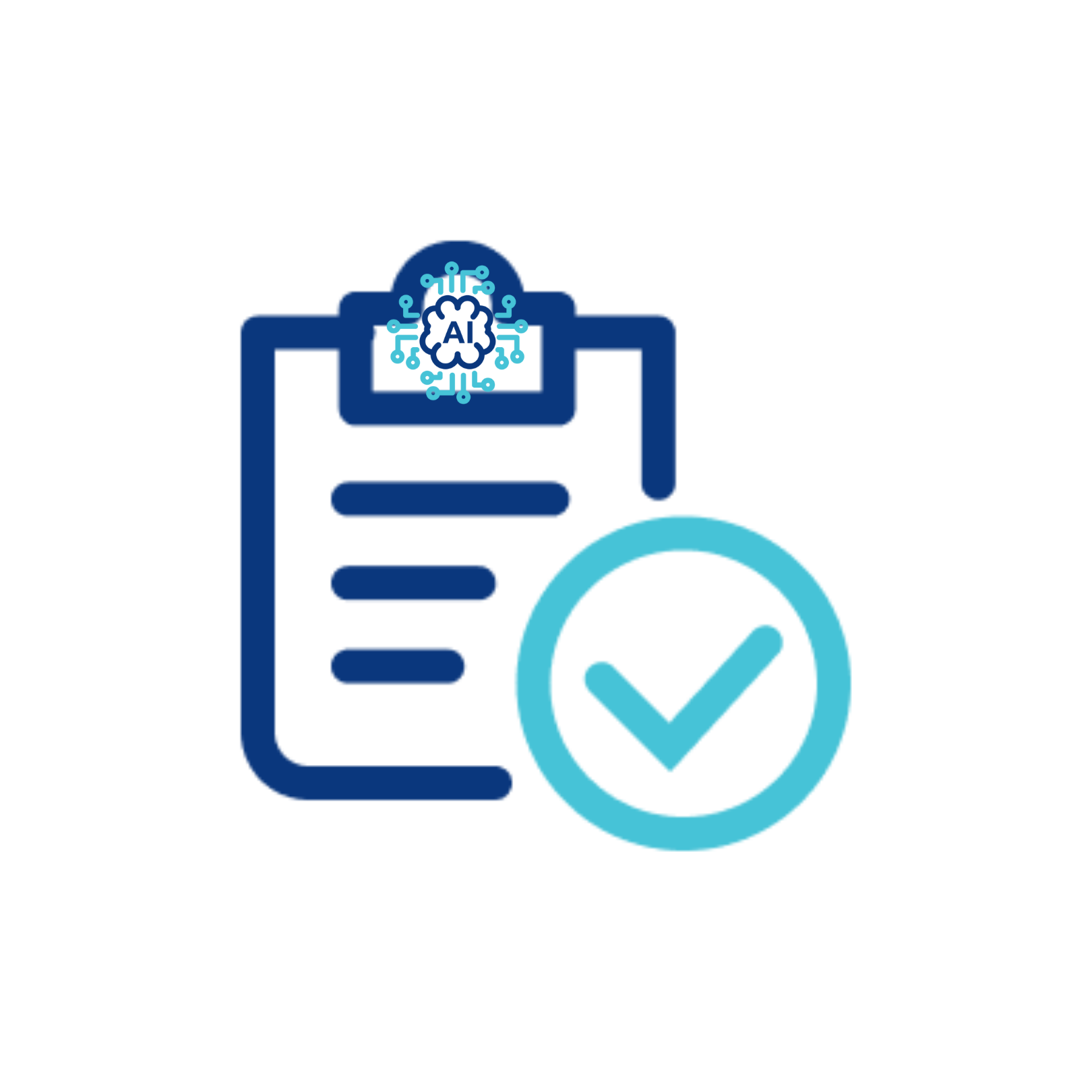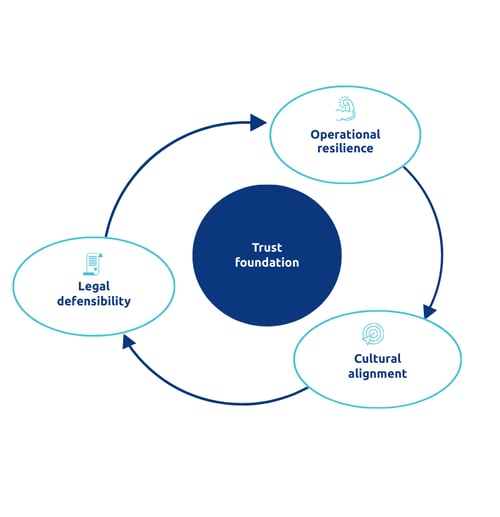6 minute read
Policy Compliance with AI: From Burden to Advantage
Discover how policy compliance with AI improves interpretation, enforcement, and audit readiness across healthcare, life sciences, and finance.
Table of contents

Writing a policy isn’t hard. The real challenge is what comes after:
- Clear interpretation
- Consistent application
- Real-time enforcement
- Proving compliance.
The strategic importance of policy comprehension
Why understanding corporate policies matters
In any enterprise, the ability to consistently uphold ethical standards and regulatory compliance is foundational to building trust - both internally and externally. Yet, the process of reading, interpreting, and applying corporate policies is often viewed as tedious or secondary to daily operations.
This presents a strategic risk. Clear comprehension of policies governing areas such as professional conduct, competitive practices, data privacy, information lifecycle management, and confidentiality is essential - not just for legal defensibility, but for operational resilience and cultural alignment across the organisation.
Why it matters

The regulatory maze
The growing burden of global compliance
This challenge is further compounded by the escalating complexity of the global regulatory landscape. Enterprises today must comply with an ever-expanding array of standards - ranging from GDPR and HIPAA to SOX, ESG reporting mandates, and emerging regional laws.
These frameworks demand not only strict adherence but also transparent documentation, demonstrable internal controls, and continuous readiness for audits. The sheer volume and diversity of these obligations - often spanning hundreds of discrete policies and procedures - place a significant burden on compliance functions, especially in highly regulated industries such as healthcare, finance, and life sciences.
Key challenges:
- 100s of evolving policies
- Constant audit-readiness required
There is a need for transparent documentation, strict compliance, and constant updates.
Operational pain points
What’s holding back compliance teams?
Key operational pain points emerge from this complexity. Manual policy tracking across siloed departments, the lack of integration between governance systems, and the constant evolution of regulatory requirements result in fragmented oversight and increased risk exposure.
Disconnected systems mean that employees struggle to locate the correct policy at the time of need, leading to inefficiencies, delays, and in some cases, non-compliance.
Key challenges of compliance teams

Negative business impacts include inefficiencies, delays, and non-compliance.
Despite substantial investment in compliance infrastructure, a disproportionate volume of incoming queries - often over 30% - to legal and compliance teams involves routine, repetitive requests. These typically include clarification of policy intent, locating the latest approved document, or resolving non-scenario-based questions.
These low-complexity interactions divert expert resources from higher-value compliance activities and reflect a broader need for improved policy accessibility, self-service support, and automation.
Most affected industries
The weight of policy complexity and compliance overhead is most acutely felt in:
- Healthcare: Patient data protection, clinical standards
- Life Sciences & Pharma: GxP compliance, safety reporting, trial data governance, Regulatory submission standards, data privacy, audit traceability
- Finance: AML/KYC regulations, SOX controls, MiFID II
Capabilities that will help organisation to overcome challenges

- Semantic and intent-based search helps employees find the right policy even when terminology varies - like locating “telecommuting authorisation” when searching for “remote work approval.”
This improves accuracy and reduces compliance risks from misinterpretation. Knowledge graphs and ontologies support this by linking related terms and concepts used across the business, making search results more accurate and easier to find.
- Self-service tools like chatbots and guided workflows enable staff to access and act on policy information without relying on support teams. They promote consistent understanding and faster decision-making.
- A centralised policy hub connects documents with relevant context - such as regulations, roles, and training - making it easier to understand how policies apply in practice.
- Intelligent support systems enable automation to surface relevant policies proactively within workflows - such as during onboarding or expense submission - ensuring timely compliance and reducing the risk of oversight.
Additionally, every policy and clause can be fully versioned, deduplicated, and linked to business controls, with end-to-end lineage. This ensures transparency, audit readiness, and the ability to trace decisions back to their regulatory source.
The solution
The solution needs to transform policy management from a static burden into a dynamic, intelligent experience - designed for scale, compliance, and engagement. The capabilities include:
- Automated policy interpretation
Understand the intent behind policy language using semantic search and NLP. No more keyword-hunting - just ask, and Rover surfaces what matters.
- Real-time risks and gaps flagging
Automatically identify non-compliant patterns in content, communication, or data entries. Proactive alerts keep teams audit ready.
- Regulatory mapping
Map data flows and systems against specific compliance requirements (e.g., GDPR Article 5 or HIPAA’s Security Rule).
- Learning through play
Make compliance engaging with gamified learning - quizzes, scenario-based puzzles, and role-specific challenges to embed understanding.
- Centralised access & audit trails
Maintain a single source of truth for policies across departments with robust version control, access logs, and read confirmations.
- Intelligent Q&A support
Built-in assistant to answer questions like "What’s our policy on data retention in the EU?", "Can I share this customer data with a third-party vendor?"
In summary
Policy fatigue is real - but avoidable.
With the right tools, organisations can ensure:
- Employees get fast, accurate answers
- Compliance teams focus on complex issues
- The organisation stays resilient, informed, and audit-ready
AI meets policy: simplifying compliance for enterprise
Compliance doesn’t have to be reactive or burdensome. AI enables a proactive, intelligent approach to staying policy compliant.
Solution should bridge the gap between regulatory complexity and everyday operations - automating policy intelligence so your teams can operate with confidence.
What we need to make solution work?

Everything starts with trusted, governed data. At the foundation, secure access ensures that policies and regulations are visible only to the right people, with the right permissions.
How will the solution work?
An architecture that powers its extensible data platform, that delivers an agentic, governed, and auditable solution, designed to be adopted and customized to specific policy and compliance needs across domains.

Everything starts with trusted data. The platform ensures secure, governed access so policies and regulations are visible only to the right people, with the right permissions.

- Role-based access control
- Application and API level
- Data access
- Role-based entitlements
- Users can only see what they are allowed to
- Network segmentation
- Public
- Private (sensitive data)
- Continuous monitoring
- Open Telemetry
- OS level metrics
- User actions audit
At the foundation lies Data Access, ensuring secure and controlled access to enterprise data.

1. Identity provider identifies user and provides groups membership
2. API ensures user can only access allowed endpoints
3. Search scoped to user's entitlements
4. Application / Al Agentic workflows only see necessary data
Built on top are Data Pipelines, which seamlessly integrate and enrich information from disparate sources using pre-built classification models.

Regulations, frameworks, and internal SOPs are ingested and transformed into a single, harmonised knowledge base transforming them into a semantic knowledge graph. Content is classified, deduplicated, and linked with full versioning and lineage, making it audit-ready and easy to trace. Policies and clauses are also mapped directly to business controls and systems of record, removing ambiguity.
Intelligent AI workflows powered by agentic architecture
The AI Agentic Workflow layer introduces customisable AI processes tailored to business needs, enabling automation and insight generation at scale. The API layer provides extensive programmability, allowing custom interfaces to be built on top of enterprise data, while the UI layer caps the stack with a ready-to-use, user-friendly interface that brings the platform’s full capabilities to life.
Together, these layers form a robust and flexible architecture, enabling organisations to unlock the full value of their data - from ingestion and processing to intelligent automation and visualisation. Whether you're streamlining operations or accelerating innovation, Datavid Rover offers the technological backbone to drive data-centric success.

Use of a next-generation AI Agentic Workflow to help enterprises unlock the full potential of their data. At the heart of this system is a central Supervisor, which intelligently manages a network of specialized AI agents designed to handle complex tasks across both internal and external data sources.
These agents, powered by the latest Large Language Models (LLMs) and machine learning, work collaboratively to retrieve, analyse, and synthesize data - delivering fast, accurate, and context-aware insights through an API.
The API Layer exposes these capabilities programmatically through REST/ GraphQL, complete with audit logs and evidence APIs that plug directly into BI, GRC, reporting or custom enterprise applications. This ensures compliance insights are always available where the business needs them most, with full transparency and audit trails.

UI Layer: The Policy Hub A business-friendly dashboard brings everything together
Teams can see coverage maps, impact heatmaps, change tracking, renewal calendars, and even export auditor-ready packs. Interactive features like quizzes and attestation workflows make compliance more engaging and keep employees aligned with evolving regulations.
Together, these layers turn complex regulatory requirements into actionable policy intelligence.
Whether starting with one domain or scaling organisationwide, the platform helps enterprises move from reactive compliance to proactive, business-driven confidence.
Why it matters for the business?
- Contextual intelligence – AI agents understand your domain and surface only relevant insights.
- Scalable architecture – Start with a single policy domain and expand organisation-wide without rework.
- Business-ready output – Results are structured, exportable, searchable and ready for dashboards, analytics, chatbot or auditor packs.
- Reduced compliance burden – Teams spend less time searching for answers and more time acting with confidence.
This isn’t just search, it’s enterprise policy intelligence on demand. From pilot to full rollout, the platform hardens controls, accelerates audit readiness, and makes compliance a business enabler, not a bottleneck.
This solution/architecture can also be used to address internal investigations that often start with limited signals, like IT security alerts on potential data theft or bulk transfers. Compliance teams then face the challenge of reviewing massive volumes of unstructured data, such as emails, communication logs and SharePoint sites quickly and accurately. Ensuring evidence is complete, unbiased, and auditable while maintaining confidentiality makes these cases complex and resource intensive.
Are your policies helping your business, or holding it back?
With Datavid Rover, you can turn compliance from a burden into a competitive advantage!
Frequently Asked Questions
Why is policy comprehension such a challenge for enterprises?
While writing a policy is straightforward, the difficulty lies in its interpretation, consistent application, real-time enforcement, and provable compliance. Policies often remain static and disconnected from daily operations, creating confusion and compliance risk.
Which industries face the biggest compliance burdens?
Industries most affected by regulatory complexity include Healthcare, Life Sciences & Pharma, and Finance. These sectors face constant audit-readiness requirements, evolving policies, and high-stakes regulations like HIPAA, GxP, and AML/KYC.
How can AI improve policy compliance and reduce manual effort?
AI-powered tools - such as semantic search, knowledge graphs, and agentic workflows - enable real-time policy access, automated interpretation, and proactive risk detection. These solutions support self-service, speed up decision-making, and reduce dependence on compliance teams.
What is Datavid’s approach to transforming policy management?
Datavid offers a flexible architecture combining semantic technologies, AI agents, and intuitive UIs to turn policy management into a dynamic, intelligent process. Its solution - Datavid Rover - supports policy comprehension, audit trails, Q&A assistants, and integration into daily workflows.



